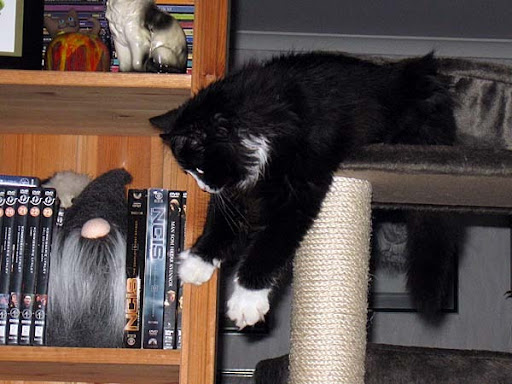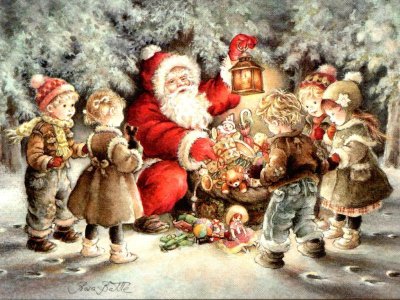Christmas Eve and "jultomten"
Posted: Sat Dec 24, 2011 9:00 am
Today is Christmas Eve, the "peak" of Christmas in Sweden. Christmas Eve is the day when "jultomten", the Swedish Santa Claus, comes with his presents to the children.

The Swedish Santa Claus, jultomten, traces his roots back to a little gray man who lived somewhere on everybody's "tomt", the plot of land that surrounds your house. And because he lived on your "tomt", he was called "tomten", "the tomt man".

"Tomten" was usually relatively nice, but you couldn't take him for granted. If you didn't treat him well, he would cause mischief. At Christmas, "tomten" demanded a bowl of fine rice porridge, otherwise he might punish you somehow or move away. And you didn't want him to leave, because he helped taking care of your animals.
This "tomte" wears a red hat, which means he has already been somewhat "Christmas-ified".
 During the 19th century, Swedish artist Jenny Nyström started painting "tomten" (plural: "tomtar" or "tomtarna") like this. They are still small and gray, but now they wear red hats (and mittens). Jenny Nyström's "tomtar" became hugely popular.
During the 19th century, Swedish artist Jenny Nyström started painting "tomten" (plural: "tomtar" or "tomtarna") like this. They are still small and gray, but now they wear red hats (and mittens). Jenny Nyström's "tomtar" became hugely popular.
The caption reads: Christmas (or Yule) with Jenny Nyström.
 As people moved into more modern houses and stopped having various other building on their "tomts", "tomten" moved away from their "tomts". But he didn't move far away. He moved somewhere into the nearest wood. When Christmas came, "tomten" was never far away.
As people moved into more modern houses and stopped having various other building on their "tomts", "tomten" moved away from their "tomts". But he didn't move far away. He moved somewhere into the nearest wood. When Christmas came, "tomten" was never far away.
At the same time, "tomten" became "jultomten", the "Christmas tomte". Because nowadays you only saw him at Christmas. Also, probably because Swedes had seen the American Santa Claus on TV, "jultomen" discarded his gray clothes and started wearing red.
 "Jultomten" doesn't have any reindeer, and he certainly doesn't fly. Why should he? He lives nearby. He may come in a sled drawn by horses. But then again, he usually just comes walking.
"Jultomten" doesn't have any reindeer, and he certainly doesn't fly. Why should he? He lives nearby. He may come in a sled drawn by horses. But then again, he usually just comes walking.
This is a typical Swedish "julklappsutdelning", Christmas present delivery. "Jultomten" comes home to you, of course. Nowadays the kids usually know that "jultomten" is just Dad or Grandpa or the neighbour or someone like that who has dressed up as "jultomten" to deliver the presents. In this family, the daughter has dressed up as jultomten's little helper to help jultomten deliver the gifts. Jultomten will take each gift out of his sack and read out loud who the gift is for and who it is from. If there is a verse or a rhyme on the package, he will read that, too.
Since jultomten comes home to you, he most certainly doesn't come down the chimney. How uncomfortable and impractical that would be!
 After jultomten has delivered his gifts, he usually just leaves. Or he may just take off his "jultomten outfit" and get back to being Dad or Grandpa again.
After jultomten has delivered his gifts, he usually just leaves. Or he may just take off his "jultomten outfit" and get back to being Dad or Grandpa again.
This tomte, however, is probably putting on a little show for visitors. He is sitting in an old-fashioned chair in an old-fashioned house, and he probably pretends to live there. He looks old-fashioned himself, too: he is wearing a plain Jenny Nyström style red hat without any fur trimming. He seems to be drinking something that might be "glögg", warm spicy wine which doesn't taste too good if you ask me, but which is incredibly popular here during Christmas. You only drink it at Christmas. Nobody wants to see or taste it between January and November!
And then on Christmas Day it is all over here in Sweden. Yes, we all have a holiday, so we don't go to work. But we have no traditions for Christmas Day. We used to have a rather big religious tradition on Christmas Day, requiring us all to get out of bed very early to go to a seven o'clock morning service in church, the "julotta", to celebrate the birth of Christ. But nowadays most people prefer to sleep late in the morning instead, so the "julotta" tradition is about to disappear. Many of us go to family dinners and meet our relatives on Christmas Day, though.
 But Christmas is so "Christmas Eve-centered" here in Sweden that the Swedish word for Christmas Eve, "julafton", has become a word that can be used to describe a happy day, a perfect day, or a time when you can an almost unlimited supply of things that you love.
But Christmas is so "Christmas Eve-centered" here in Sweden that the Swedish word for Christmas Eve, "julafton", has become a word that can be used to describe a happy day, a perfect day, or a time when you can an almost unlimited supply of things that you love.
This is a comic book convention, as you can see. Swedish newspapers might call such an event "'julafton' for comic book lovers".
Merry Christmas to you all!
Ann

The Swedish Santa Claus, jultomten, traces his roots back to a little gray man who lived somewhere on everybody's "tomt", the plot of land that surrounds your house. And because he lived on your "tomt", he was called "tomten", "the tomt man".
"Tomten" was usually relatively nice, but you couldn't take him for granted. If you didn't treat him well, he would cause mischief. At Christmas, "tomten" demanded a bowl of fine rice porridge, otherwise he might punish you somehow or move away. And you didn't want him to leave, because he helped taking care of your animals.
This "tomte" wears a red hat, which means he has already been somewhat "Christmas-ified".

The caption reads: Christmas (or Yule) with Jenny Nyström.

At the same time, "tomten" became "jultomten", the "Christmas tomte". Because nowadays you only saw him at Christmas. Also, probably because Swedes had seen the American Santa Claus on TV, "jultomen" discarded his gray clothes and started wearing red.

This is a typical Swedish "julklappsutdelning", Christmas present delivery. "Jultomten" comes home to you, of course. Nowadays the kids usually know that "jultomten" is just Dad or Grandpa or the neighbour or someone like that who has dressed up as "jultomten" to deliver the presents. In this family, the daughter has dressed up as jultomten's little helper to help jultomten deliver the gifts. Jultomten will take each gift out of his sack and read out loud who the gift is for and who it is from. If there is a verse or a rhyme on the package, he will read that, too.
Since jultomten comes home to you, he most certainly doesn't come down the chimney. How uncomfortable and impractical that would be!

This tomte, however, is probably putting on a little show for visitors. He is sitting in an old-fashioned chair in an old-fashioned house, and he probably pretends to live there. He looks old-fashioned himself, too: he is wearing a plain Jenny Nyström style red hat without any fur trimming. He seems to be drinking something that might be "glögg", warm spicy wine which doesn't taste too good if you ask me, but which is incredibly popular here during Christmas. You only drink it at Christmas. Nobody wants to see or taste it between January and November!
And then on Christmas Day it is all over here in Sweden. Yes, we all have a holiday, so we don't go to work. But we have no traditions for Christmas Day. We used to have a rather big religious tradition on Christmas Day, requiring us all to get out of bed very early to go to a seven o'clock morning service in church, the "julotta", to celebrate the birth of Christ. But nowadays most people prefer to sleep late in the morning instead, so the "julotta" tradition is about to disappear. Many of us go to family dinners and meet our relatives on Christmas Day, though.

This is a comic book convention, as you can see. Swedish newspapers might call such an event "'julafton' for comic book lovers".
Merry Christmas to you all!
Ann